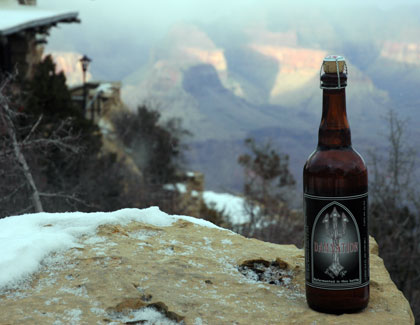This New York Post features Aviram Turgeman, New York’s first beer sommelier.
Cheers to Cafe D’Alsace for showcasing beer as much as wine. “I love beer, and we had a lot of great beers at L’Express (the bistro on Park Avenue South he also owns), but no one knew about them,” said owner Simon Oren.
The restaurant does all the right things: a well-resented menu, good glassware, and Turgeman suggests beer and food pairings. This has to be a step in the right direction for beer.
But can you really have a beer sommelier? Dictionary.com defines sommelier as “A restaurant employee who orders and maintains the wines sold in the restaurant and usually has extensive knowledge about wine and food pairings.” That would make wine sommelier redundant and beer sommelier meaningless.
But enough of semantics. While you might be able to just call yourself a beer sommelier, nor there is no legal requirement in the U.S. to be certified as a wine sommelier, if you want to put M.S. (Master Sommelier) after your name that’s an entirely different matter.
The Court of Master Sommeliers requires candidates pass three levels of examinations. The first level is the Introductory Sommelier Course. Next is the Advance Course. SF Sommelier Consulting provides this description of the Advanced Course exam:
The first section is theory. It is an 82 question test with 20 multiple choice and 62 short answer questions. One hour is allowed for completion.
The second section is blind tasting. The candidate enters a room with a table with six glasses of wine on it and two Master Sommeliers sitting on the opposite side of the table. They listen as you swirl, sniff, taste and talk about each wine. You have 25 minutes total to identify all six. These wines can be from anywhere in the world, but they stick to classic examples. Points are given for your analysis and deductive reasoning as well as your identification of the wines.
The final section is the hardest of all. Restaurant service somehow seems harder when it is in a test environment. There are service stations where the Master Sommeliers judge your skills at opening still and sparkling wines, decanting, cigar service, freehand pouring of spirits, wine and food pairing, proof reading of wine lists, setting tables for a variety of menus, conversing with the guests and complaint resolution. While this is going on they also throw questions at you to see how you react. A passing score of 60% is required on all three sections. Approximately 25% of candidates pass this exam.
Pass that an you qualify for the Master Dipolma exam, which is even tougher. Then you can put M.S. after your name.
For the record, there are 74 professionals who hold the title Master Sommelier in North America. Of the North American Master Sommeliers, 61 are men and 13 are women. There are a total of 120 Master Sommeliers worldwide.
But only one (so far) beer sommelier in New York.
